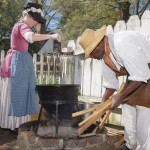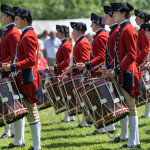
It was 1958 and the leader of the newly-created Colonial Williamsburg militia needed fifers to accompany his drummers at militia musters. One night he appeared at the front door of a residence on Duke of Gloucester Street with a handful of fifes. This is just one of the tales you might hear on the Behind the Field Musick tour with John Harbour, one of its original members.
If you love watching the Corps march down Duke of Gloucester St., if you’re curious about its history, or if you’ve ever wondered what a practice looks like, here’s your chance.
John arrives early at the shelter at the corner of Nicholson and Botetourt Streets, where the tour begins. He passes around a binder with snippets of information about uniforms, instruments, and history.
At the appointed time, John leads the group down Nicholson and through an employee parking lot to Franklin St., where the Fifes and Drums Building has stood since 1980.
The entryway is a mini-museum of the Corps’ history. “We put this exhibit together in 2013 for our 55th anniversary primarily for the kids, to give them a sense of the legacy of this organization,” says John. Behind the scenes tours began in 2014.
The walls are lined with pictures of each class, telling their own story of Colonial Williamsburg’s evolution. Different hats and uniforms, of course; but also changes in the landscape, evidenced by a photograph of Duke of Gloucester St. thick with trees. Others highlight participation in the Macy’s Parade, major events, and photo ops with political leaders.
John has answers to all sorts of questions. Why does the uniform look so similar to British redcoats? What’s the biggest drum they ever used? Why do 18th-century drums sound different?
And he can point directly to many of the answers. The exhibit features some of the different uniforms worn by the corps. All made by our own Costume Design Center, and all wool. More than one musician has gotten woozy while standing in formation.
Every drum with the exception of those on display is still in use. Some line the rehearsal space; others are stored in a vented storage closet; yet more await repair in a back room.
One of the first original bass drums was made of barrel staves. “Our first bass drummer was six-foot-three. He was the only guy who could carry it.”
A fife is a simple wooden instrument, with six finger holes and a mouth hole. It can play three registers; the more complicated finger combinations come in with the third register. It is keyed in B flat, similar to a clarinet.
One display case contains 32 examples of every variety of fife that has been used at Colonial Williamsburg since the program began 1958. They are made of all sorts of hardwood—ebony, maple, rosewood, cocobolo, and more. The Cooperman Company has manufactured Colonial Williamsburg fifes since 1963.
Many are on loan from alumni. One belongs to John. It’s the very first fife in the history of the corps. In the early years the fifes (20th-century replicas, of course) could be tuned simply by sliding the instrument’s two pieces in or out.
In 1964, the switch was made to a more authentic instrument based on an 18th-century fife in Colonial Williamsburg’s collections. The pitch on these “old pitch fifes,” still in use today, can be adjusted by maneuvering the position of the cork just inside the mouth hole on the left.
Williamsburg’s corps represents the Virginia State Garrison Regiment established by the Virginia legislature in 1778. Fifers and drummers served as a vital communication tool in 18th-century armies.
Each company would have one fifer and one drummer. Likewise, the commanding officer and his adjutant would each have one of each. Throughout the day, they would provide the music that signaled the day’s activities, such as reveille and tattoo (which summoned soldiers back to camp at dusk). On the march to battle the fifers and drummers would assemble as one to provide what was called the field music, allowing the officers to command the soldiers.
The junior and senior corps perform every day, in all hundreds of times a year. Later this month they’ll take the stage for the Virginia International Tattoo in Norfolk, one of the largest displays of military music in the world.
As John has been talking, the members of the senior corps have been streaming in and getting dressed in preparation for the day’s march.
But first, it’s time for rehearsal, and the tour is allowed in to watch. Each of us plucks a pair of ear plugs from the dispenser near the door. You need them. It’s awfully loud in the cozy confines of the rehearsal hall.
“When I started, we had three songs we played for two years. We got really tired of them,” says John.
It’s a bit different today. Each year, a repertoire of 50-60 tunes is selected out of the thousands collected in the music library. Over the course of their tenure, members commit more than 300 tunes to memory and you never know what the sergeant major is going to call out to play. And they’d better know it.
Stewart Pittman, head of the Fife and Drum Corps, leads the rehearsal as the drum major. He stands in front with a large mace, which he will use to signal the musicians.
A chart behind him features tags that indicate the rank of every member. “This is a serious professional musical organization. We expect an eight-year commitment. We expect you to pass through the ranks,” says John.
The practice runs less than half an hour before it’s time to head over to the Capitol for the 4:50 march to the Courthouse and the daily “On to Yorktown” program. It’s a beautiful day, so we join the march.
The Behind the Field Musick Tour is offered on Fridays at 4 p.m., exclusively for Annual Pass members, Good Neighbor Pass members, and Colonial Williamsburg hotel guests. A free event ticket is required.


I’ve always enjoyed watching and listening to the corps, and this article was very informative. Could you please tell me what size your field snare drums are, and are they made by Cooperman, like your fifes? Thanks!
What happens to the old drums when they are replaced with new ones? Are they for sale?
Thanks
Thanks for your question. Old drums aren’t replaced, they’re rebuilt.. We’re still using some drums from the 1960s.. We get all our drums from Cooperman, a wonderful company in Bellows Falls, Vermont.
I was fortunate enough get in on this tour two years ago….very neat and very LOUD…lot of fun. We followed them through the cane brake to the coffeehouse backyard…another CW hidden trail.
Love the fife and drum…they always make my trip memorable every year.
We love the entire program. Our son in new to the Junior Corpse as a drummer this year. CW, thanks for a great job!
Love their music and professionalism. What determines if they wear red dress uniforms or hunting coats? My wife and I were in CW this week celebrating our 20th anniversary. As always a wonderful time, stayed in the Orrel House as we did on our honeymoon 20 years ago!
I think both the Jr. and Sr. Corps where their hunting frocks during the Christmas season only.
We have two Fife & Drum Corps: The Jr. Corps, which represents early Revolutionary war militia field music, wears the white hunting frocks with civilian style breeches and waistcoats-a common practice throughout the Colonies leading up to the recruiting and outfitting of the professional American army by the mid 1770’s. The Sr. Corps, representing the field music of the VA State Garrison Regiment formed in 1778, wears a red regimental coat and military style smallclothes typical of Continental Army musicians towards the end of the war. Between the two, we have the ability to interpret a broader span of military history at Colonial Williamsburg.
Are there times when a “mixed” group of Junior and Senior Corps members must play (such as during times of availability gaps like school break weeks), and if so, can we assume that the Corps that day would ear white in deference to the Junior members present?
Also, a BIG thank you and ovation to Msrs. Harbour and Pittman for providing their vast knowledge of the Fife and Drum Corps history and 18th Century music — making the Behind the Field Musick tour a MUST for my family when we visit CW!!
Occasionally we do mix and you are correct; When we have Seniors playing with Juniors, we all wear the white hunting frocks.
I had the absolute pleasure of meeting John Moon years ago - he, Dorothy Poucher, Mary K. Wiseman, and other WONDERFUL CW folks gave a seminar to 18th c reenactors. That seminar made most of us greedy for more, and took a lot of us deeper into living history, and doing a better job of it. It also took a lot of us deeper into English country dancing. I wish you all would do more dance programs!!!!! I know Mary is often up at Mt. Vernon - someday I hope to see Dorothy and Dan again. I think it is the sights and sounds of Williamsburg that stay with visitors most, and keep them interested in the history part - and in coming back to CW again and again! T H A N K Y O U ! ! ! ! ! !